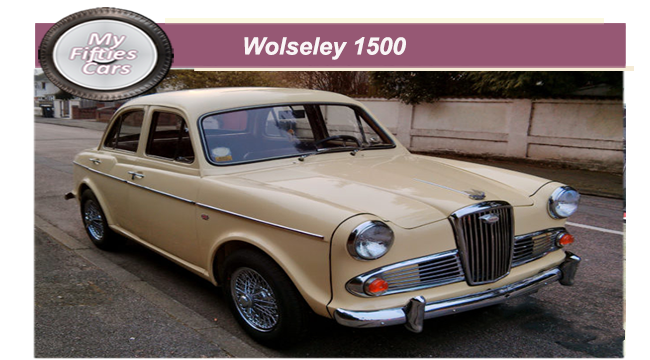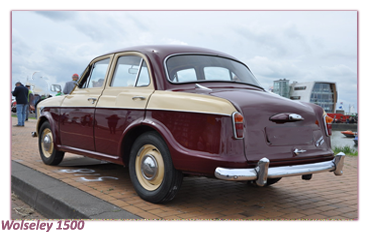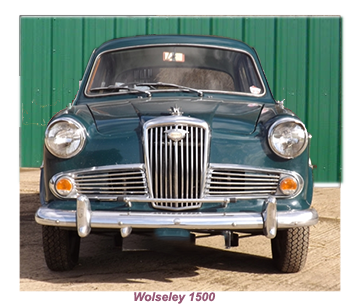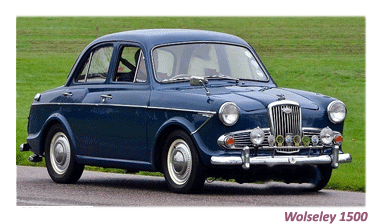
Towards the middle of the Nineteen Fifties, with the organisation levels at BMC still in a state of turmoil after the major amalgamation that took place, the top management of what was then U.K.’s larger motor manufacturing group began to look upon Wolseley as something of a dumping ground for field projects.
T hat’s the reason why many motoring commentators of the period suggest that the Wolseley 1500, launched in 1957 was simply a model that wasn't meant to be.
hat’s the reason why many motoring commentators of the period suggest that the Wolseley 1500, launched in 1957 was simply a model that wasn't meant to be.
 The last project to be released partially designed for BMC by industry icon Gerald Palmer before he left the group to join Vauxhall motors in 1955, the Wolseley 1500 was initially intended to be reproduced as the Morris 1200, to be a replacement for the recently introduced Morris Minor 1000.
The last project to be released partially designed for BMC by industry icon Gerald Palmer before he left the group to join Vauxhall motors in 1955, the Wolseley 1500 was initially intended to be reproduced as the Morris 1200, to be a replacement for the recently introduced Morris Minor 1000.
 DWith BMC arriving at the realisation that they sell as many 1000’s that they could produce, the idea of phasing out the car became increasingly ridiculous.
DWith BMC arriving at the realisation that they sell as many 1000’s that they could produce, the idea of phasing out the car became increasingly ridiculous.
Eventually the decision was reach that instead of discarding all of Palmer’s excellent design work, the Morris Minor 1200 was rapidly re-badged to become the Wolseley 1500.
![]()
 This latest addition to the Wolseley stable made its public debut at the London Motor Show in April 1957 where it was the subject of subdued public and trade response.
This latest addition to the Wolseley stable made its public debut at the London Motor Show in April 1957 where it was the subject of subdued public and trade response.
As ever BMC continued to re-badge every new model, introducing a Riley version of 1500, the 1.5 with a few minor developments from the Wolseley 1500 although sitting on the same superstructure.
 Originally planned to be fitted with the 1.2-litre engine developed for the Morris Minor 1200, the Wolseley 1500 (and the Riley 1.5) was eventually launched, equipped with a 1489cc (91 Cu in) engine, an offshoot of the original BMC B-series engine.
Originally planned to be fitted with the 1.2-litre engine developed for the Morris Minor 1200, the Wolseley 1500 (and the Riley 1.5) was eventually launched, equipped with a 1489cc (91 Cu in) engine, an offshoot of the original BMC B-series engine.

 During the three years that it was in production, the Mk I version of the Wolseley 1500 was given very few updates by BMC and eventually upgraded to the Mk II version in May 1960.
During the three years that it was in production, the Mk I version of the Wolseley 1500 was given very few updates by BMC and eventually upgraded to the Mk II version in May 1960.
The Mk II version of the 1500 was almost identical to the Mk I, with the principal difference being that the car's bonnet and boot hinges were now intrinsic.
 On the other hand, when the Mk III version of the 1500 was introduced the following year, it had been the recipient of some fundamental cosmetic changes, including a new front grille and revamped rear taillights, as well as lower suspension.
On the other hand, when the Mk III version of the 1500 was introduced the following year, it had been the recipient of some fundamental cosmetic changes, including a new front grille and revamped rear taillights, as well as lower suspension.
The general opinion was that it would have taken a very practiced eye to distinguish between any of the three generations of the Wolseley 1500, which was eventually discontinued in 1965 to be replaced by the front-wheel-drive Wolseley 1100.


